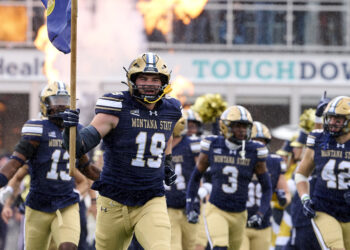By Patrick Straub Explore Big Sky Fishing Columnist
Large flakes of snow fall to the water’s surface, disappearing the moment they land. A moose devours a mouthful of willows across the river. My cold fingers fumble in my fly box for a size 22 Buzzball.
It’s one of those storybook winter days with no wind, no one else on the river, and no need for a strike indicator because I’m fishing dry flies on the surface. I feel like I’m the first person ever to fish this well-known run on the Gallatin. Then, in the distance I see an angler walking downstream to talk to me. When he arrives he explains his struggles, saying he hasn’t gotten a fish all day.
I ask him what he’s using and he says, “Oh, just this little beadhead.”
“That might work,” I say. “But the fish seem to be rising sporadically to adult midges today.” I hand him a few Buzzball dry flies and suggest he lengthen his leader and tie on a Buzzball.
“Never seen those before,” he says.
Fly selection is essential to angling success – without the correct fly you’re not imitating the available food source. In no particular order, here are my six favorite patterns – well, technically seven due to a tie – for the next month on our local waters.
LaFontaine’s Buzzball. Gary LaFontaine, a fishing and fly-tying pioneer, developed this simple pattern. While fishing the Missouri River in winter, he struggled to imitate clustering midges, so he created the Buzzball. This pattern is extremely effective on the Gallatin, Yellowstone, and Missouri rivers, but it should work anywhere midge clusters get thick and gooey. LaFontaine’s original pattern was tied without a high-visibility wing, but recent tiers added the wing for better visibility. When fishing the Buzzball, I like to put fly floatant on my leader so the fly floats higher on the surface.
Pat’s Rubberlegs/Girdle Bug/Crazy Legs. Is there any time of year this fly doesn’t catch fish? A stonefly imitation at its core, this simple fly just works. Dead-drift it under an indicator as a nymph on its own, or use it as a lead fly in a two-fly setup. The rubber legs flex and pulse in the current adding life to the fly, and the chenille color can vary to match any shade of stonefly. Black, brown and variegated black-and-brown are also very effective colors. For the next six weeks it’ll be rare when a Pat’s Rubberlegs isn’t the first fly I tie on when fishing weighted nymphs. Sizes 8, 10, and 12 will be most successful.
Firebead nymphs. As our rivers transition from winter to spring, trout will be on the lookout for easy meals with lots of calories, and a firebead appears that way. Firebeads burst onto the angling scene about 10 years ago. Some argue that the firebead imitates an egg – we’ll never know what a trout is thinking when eating a fly – but there’s no argument about its effectiveness.
Beadhead Zebra midge. If I had been exposed to this fly earlier in my angling career, I would have caught many more trout. It’s a fly tied to imitate a midge pupa or emerging midge, and midges are prominent in every trout river, year round. However, the Zebra is not just for imitating midges. I’ll fish this as a mayfly on the Paradise Valley spring creeks, as caddis on the Madison River, and as freshwater shrimp on the Bighorn River in Wyoming. Drop it under your favorite dry fly and few rising trout can resist.
Tie: Zuddler and Sculpzilla. A well-respected Big Sky angler and I debated at length which pattern would be more effective these next few weeks. After our thumb wrestling competition resulted in my seventh-round loss, I agreed to include the Zuddler. Both patterns are intended to imitate baitfish and larger food sources – such as crayfish – found in our local waters. They can be fished with action, or dead-drifted under an indicator.
Parachute Purple Haze. Now is when Blue Winged Olives could hatch on any given day. A regular Parachute Adams will work fine, but in seeing thousands of fish eat dry flies on various Parachutes, the purple body makes a difference. LaFontaine was a believer in the way light refracts off a fly. I am too, and there’s something about purple. Longtime Yellowstone River guide Stephen Leibinger says this of the Parachute Purple Haze: “It’s the only dry fly I carry in all sizes, from 8 to 22, because it works in so many situations.” The Purple Haze will put a spell on you.
Armed with the proper fly and the right amount of faith, your early spring fishing should be rewarding.
Pat Straub is the author of six books, including “The Frugal Fly Fisher,” “Montana On The Fly,” and “Everything You Always Wanted to Know About Fly Fishing.” He and his wife own Gallatin River Guides in Big Sky and along with a partner owns a guide service on the Missouri River.













